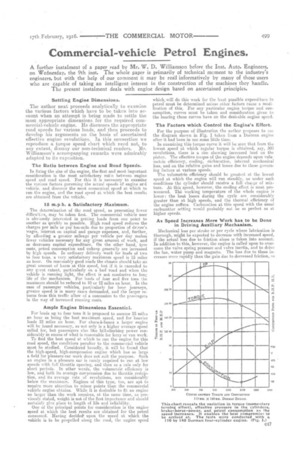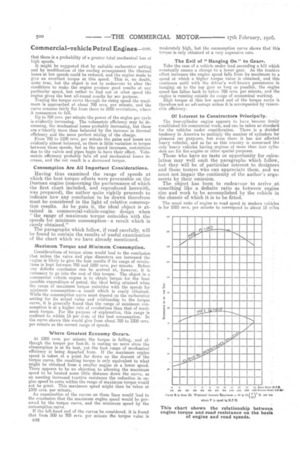Commercial-vehicle Petrol Engines.
Page 13

Page 14

Page 15

If you've noticed an error in this article please click here to report it so we can fix it.
A further instalment of a paper read by Mr. W. D. Williamson before the Inst. Auto. Engineers, on Wednesday, the 9th inst. The whole paper is primarily of technical mcment to the industry's engineers, but with the help of our comment it may be rea"d informatively by many of those users who are capable of taking an intelligent interest in the construction of the machines they handle.
The present instalment deals with engine design based on ascertained principles.
Settling Engine Dimensions.
The author next proceeds analytically to examine the various factors which have to be taken into account When an attempt is being made to settle the most appropriate dimensions for the required commercial-vehicle engine. He discusses the appropriate road speeds for various loads, and then proceeds to develop his arguments on the basis of ascertained effective engine revolutions. In this connection we reproduce a torque speed chart which need not, to any extent, dismay our non-technical readers. Mr. Williarason's accompanying remarks were admirably adapted to its exposition.
The Ratio between Engine and Road Speeds.
In fixing the size of the engine, the first and most important consideration is the most satisfactory ratio between engine speed and road speed. For this it is necessary to examine the various factors governing the actual speeds of engine ard vehicle, and discover the most economical spied at which to run the engine, and the road speed at which the best results are obtained from the vehicle.
•
15 m.p.h. a Satisfactory Maximum.
. The determination of the road speed, as presenting fewer difficulties,may be takenfirst, The commercial vehicle user is obviously interested in getting loads from ono point to another as quickly as possible, High road speed reduces the charges per mile or per ton-mile due to proportion of driver's wages. interest on capital and garage expenses, and, further, by affording, a greater mileage per vehicle per day makes fewer vehicles necessary for any given amount of work, and so decreases capital expenditure. On the other hand, tyre costs, petrol consumption and upkeep generally are increased by high speeds. In ordinary delivery work for loads of two to four tons, a very satisfactory maximum speed is 15 miles an hour. On reasonably good roads the chassis should take no great amount of harm at this speed, but if it is exceeded to any great extent, particularly on a bad 'road and when the vehicle is running light, the effect is not conducive to long life of the mechanism. For loads of four and five tons the maximum should be reduced to 10 or 12 miles an hour. In the case of passenger vehicles, -particularly for long journeys, greater speed is in many cases demanded, and the larger returns from this traffic allow of a concession to the passengers in the way of increased running costs.
Ample Engine Dimensions Essential.
For loads up to four tons it is proposed to assume 15 miles an hour as being the best maximum speed, and for heavier loads 12 miles an hour. For chars-a-bancs a larger engine will be found necessary, as not only is a higher average speed called for, but passengers also like hill-climbing power considerably in excess of what is reasonable for lorry or van work.
To find the best speed at which to run the engine for this road speed, the conditions peculiar to the commercial vehicle must be studied. Considered broadly, it will be found that the high-speed, high-compression engine which has so large a field for pIeasnre-car work does nut suit the purpose. Such an engine in a pleasure car is rarely required to run at low speeds with full throttle opening, and then as a rule only for short periods. In other weeds, the volumetric efficiency is low, and both its average compression due to throttle restriction, and its average rate of revolutions, are considerably below the maximum. Engines of this type, too, are apt to require more attention to minor points than the commercial Thiele engine obtains. While it is desirable to fit an engine no larger than the work requires, at the same time, as previously stated, weight is not of the first importance and should certainI2i• give place to length of life and reliability.
One of the principal points for consideration is the engine speed at which the best results are obtained for the petrol consumed. . Having decided'. upon the speed at which the vehicle is to be propelled along the road, the engine speed
whichovill do this work for the least possible expenditure in petrol must be determined unless other factors cause a modification of this. For any particular engine torque and consumption, curves most be taken arid consideration given to the bearing these curves have on the desirable engine speed.
The Factors which Control the Engine's Effort.
For the purpose of illustration the author proposes to use the diagram shown in Fig. 1 taken from a Dorman engine after it had been in use some little time.
In examining this torque curve it will be seen that from the lowest speed at which regular torque is obtained, say, 300 revolutions, there is a rise showing increased load on the piston. The effective torque of the engine depends upon nal-in metric effidency, cooling, ciirburation, internal mechanical loss, and on the relative gains and losses due to these governing factors at various speeds.
The volumetric efficiency should be greatest at the lowest speed at which the engine will run steadily, as under such conditions the cylinder should receive a full charge of mixture. At this speed, however, the cooling effect is most pronounced. The working temperature of the whole engine is lower: the heat losses during the cycle are considerably greater than at high speeds, and the thermal efficiency of the engine suffers. Carburation at this speed with the usual carburetter setting would probably not be as perfect as at higher speeds.
As Speed Increases More Work has to be Done in Driving Auxiliary Mechanism.
Mechanical loss per stroke or per cycle where lubrication is thorough, might be expected to decrease with increased speed, if the actual loss due to friction alone is taken into account. In addition to this, however, the engine is called upon to overcome the valve spring pressure and valve inertia, and to drive the fan, water pump and magneto. The loss due to these increases more rapidly than the gain due to decreased friction, so that there is a probability of a greater total mechanical loss at high speeds.
It might be suggested that by suitable carburetter setting and by modification of the cooling arrangement the thermal losses at low speeds could be reduced, and the engine made to give an excellent torque at this speed. This is, no doubt, quite true, but the object is not to endeavour to alter the conditions to make the engine produce good results at any particular speed, but rather to find out at what speed the engine gives the best all-round results for out purpose. Tracing the torque curve through its rising speed the maximum Is approached at about 700 revs, per minute, and the curve remains fairly flat from there to 1000 revolution; where it commences to fall.
Up to 700 revs, per minute the power of the engine per cycle is evidently increasing. The volumetric efficiency may be decreasing, the mechanical losses probably increasing, but these are evidently more than balanced by the increase in thermal efficiency and the more perfect mixing of the charge. From 700 to 1100 revs, per minute the gains and losses are evidently almost balanced, as there is little variation in torque between those speeds, but as the speed increases restrictions due to the valves and pipes begin to have their effect. Volumetric efficiency probably falls off and mechanical losses increase, and the net result is a decreased torque.
Consumption Are AU Important Considerations.
Having thus examined the range of speeds at which the best torque effects were procurable on the Dorman engine (concerning the performance of which the first chart included, and reproduced herewith, was prepared), the author quite rightly proceeds to indicate how any conclusion to be drawn therefrom must be considered in the light of relative consumption results. As he puts it, the ideal object is attained in commercial-vehicle-engine design when "the range of maximum torque coincides with the speeds for minimum consumption—a result. which is rarely obtained."
The paragraphs which follow, if read carefully, will be found to contain the results of useful examination of the chart which we have already mentioned.
Maximum Torque and Minimum Consumption.
Considerations of torque alone would lead to the conclusion that unless the valve and pipe diameters are increased the cngine is likely to give the best results if its range of revolutions is kept between 700 and 1100 revs, per minute. Before any definite conclusion can be arrived at, however, it is necessary to go into the cost of this torque. The object in a commercial vehicle engine is to obtain torque for the least possible expenditure of petrol, the ideal being attained when the range of maximum torque coincides with the speeds for minimum consumption—a result which is rearly obtained. While the consumption curve must depend on the carburetter setting for its actual value and relationship to the torque curve, it is generally found that the range of minimum consumption is at a higher rate of revolutions than that of maximum torque. For the purpose of explanation, this range is confined to within 15 per cent, of the best consumption. In the curve shown this would give from about 700 to 1300 revs. per minute as the correct range of speeds.
Where Greatest Economy Occurs.
At 1300 revs, per minute the torque is falling, and although the torque per foot-lb. is costing no more since the consumption is at its best, yet the best range of mechanical efficiency is being departed from. If the maximum engine speed is taken at a point far down on the descent of the torque curve, the resulting torque is only equivalent to what might be obtained from a smaller engine at a lower speed. There appears to be no objection to allowing the maximum speed to be located some little distance down the curve, as on meeting increased tractive resistance the reduction in engine speed to come within the range of maximum torque would not be great. This maximum speed might then be taken at 1300 revs, per minute.
An examination of the cuives on these lines would lead to the conclusion that the maximum engine speed would be govmeted by the torque curve, and the minimum speed by the consumption curve.
If the left-hand end of the curves be considered, it is found that from 500 to 700 revs, per minute the torque value is C48
The Evil of "Hanging On' to Gears.
Take the case of a vehicle under load ascending a bill which eventually causes a change to a lower gear. As the tractive effort increases the engine speed falls from its maximum. to a speed at which a higher torque value is obtained, and this continues until with the driver's well-known persistence in hanging on to the top gear as long as possible, the engine speed has fallen back to below 700 revs, per minute, and the engine is running outside its Hinge of economical working. ugh torque at this low speed end of the torque curve is therefore not an advantage unless it is accompanied by reasonable efficiency.
Of Interest to Constructors Principally.
The four-cylinder engine appears to have become firmly established for commercial work, and can be taken as standard for the vehicles under consideration. There is a decided tendency in America to multiply the number of cylinders for pleasure car purposes, but even there it has not affected heavy vehicle's, and as far as this country is concerned the only heavy vehicles having engines of more than four cylinders are for fire engine or other special purposes. Those who have no taste or opportunity for calculation may well omit the paragraphs• which follow, but they will be of particular interest to designers and those testers who can appreciate them, and we must not impair the continuity of the author's arguments by their omission. The object has been to endeavour to arrive at something like a definite ratio as between engine size and work .te he accomplished by the vehicle in the chassis of which it is to be fitted.
The usual ratio of engine to road speed in modern vehicles is for 1000 revs, per minute to correspond to about 15 miles
per hour, but for any engine with curves corresponding to Fig. 1 there is a decided advantage in increasing the engine speed to 1300 revs, per minute. Not only is the consumption improved, but the increased speed allows a decrease in engine size for ary given weight of vehicle, with a corresponding lightening of transmission parts up to but not including the final drive. For the engine under consideration it is proposed to assume 1300 engine revs, per minute for 15 miles per hour. The next step is to arrive at some formula to give the actual figures for engine sizes to meet particular requirements. In the following method the author has aimed at obtaining a formula that is easy to handle rather than one which will give accuncy to a large number of decimal places. The useful work obtained from the engine per minute is represented in foot-lb. by Mean effective brake pressure x area of cylinder in sq. in. x stroke in feet x number of working strokes. Let V represent volume of one cylinder in cu. in.




















